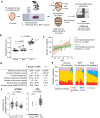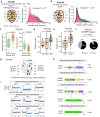Spatial architectures of somatic mutations in normal prostate, benign prostatic hyperplasia and coexisting prostate cancer
- PMID: 38172600
- PMCID: PMC10834420
- DOI: 10.1038/s12276-023-01140-8
Spatial architectures of somatic mutations in normal prostate, benign prostatic hyperplasia and coexisting prostate cancer
Abstract
This study aimed to identify somatic mutations in nontumor cells (NSMs) in normal prostate and benign prostatic hyperplasia (BPH) and to determine their relatedness to prostate cancer (PCA). From 22 PCA patients, two prostates were sampled for 3-dimensional mapping (50 normal, 46 BPH and 1 PCA samples), and 20 prostates were trio-sampled (two normal or BPH samples and one PCA sample) and analyzed by whole-genome sequencing. Normal and BPH tissues harbored several driver NSMs and copy number alterations (CNAs), including in FOXA1, but the variations exhibited low incidence, rare recurrence, and rare overlap with PCAs. CNAs, structural variants, and mutation signatures were similar between normal and BPH samples, while BPHs harbored a higher mutation burden, shorter telomere length, larger clone size, and more private NSMs than normal prostates. We identified peripheral-zonal dominance and right-side asymmetry in NSMs, but the asymmetry was heterogeneous between samples. In one normal prostate, private oncogenic RAS-signaling NSMs were detected, suggesting convergence in clonal maintenance. Early embryonic mutations exhibited two distinct distributions, characterized as layered and mixed patterns. Our study identified that the BPH genome differed from the normal prostate genome but was still closer to the normal genome than to the PCA genome, suggesting that BPH might be more related to aging or environmental stress than to tumorigenic processes.
© 2023. The Author(s).
Conflict of interest statement
The authors declare no competing interests.
Figures




Similar articles
-
Whole-exome sequencing of Nigerian benign prostatic hyperplasia reveals increased alterations in apoptotic pathways.Prostate. 2024 Apr;84(5):460-472. doi: 10.1002/pros.24662. Epub 2024 Jan 8. Prostate. 2024. PMID: 38192023 Free PMC article.
-
The architecture of clonal expansions in morphologically normal tissue from cancerous and non-cancerous prostates.Mol Cancer. 2022 Sep 22;21(1):183. doi: 10.1186/s12943-022-01644-3. Mol Cancer. 2022. PMID: 36131292 Free PMC article.
-
Organ-wide telomeric status in diseased and disease-free prostatic tissues.Prostate. 2010 Sep 15;70(13):1471-9. doi: 10.1002/pros.21182. Prostate. 2010. PMID: 20687220 Free PMC article.
-
Prostate stem cells in the development of benign prostate hyperplasia and prostate cancer: emerging role and concepts.Biomed Res Int. 2013;2013:107954. doi: 10.1155/2013/107954. Epub 2013 Jul 8. Biomed Res Int. 2013. PMID: 23936768 Free PMC article. Review.
-
[Correlation of androgen receptor CAG repeats with the risks of benign prostatic hyperplasia and prostate cancer: a meta-analysis].Zhonghua Nan Ke Xue. 2014 Feb;20(2):172-6. Zhonghua Nan Ke Xue. 2014. PMID: 24520673 Chinese.
References
-
- Fowler JC, et al. Selection of oncogenic mutant clones in normal human skin varies with body site. Cancer Discov. 2021;11:340–361. doi: 10.1158/2159-8290.CD-20-1092. - DOI - PMC - PubMed
MeSH terms
Grants and funding
LinkOut - more resources
Full Text Sources
Medical

